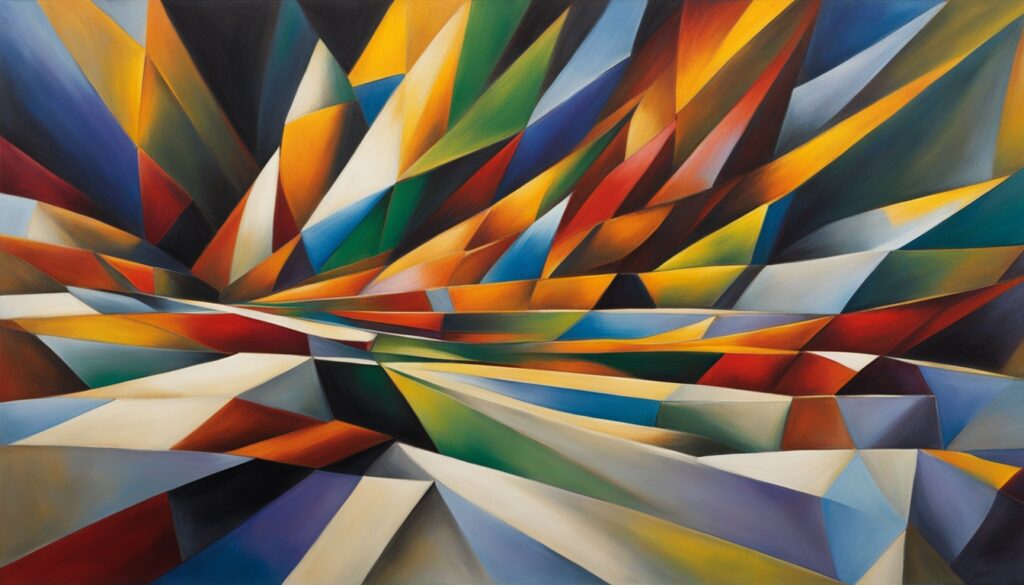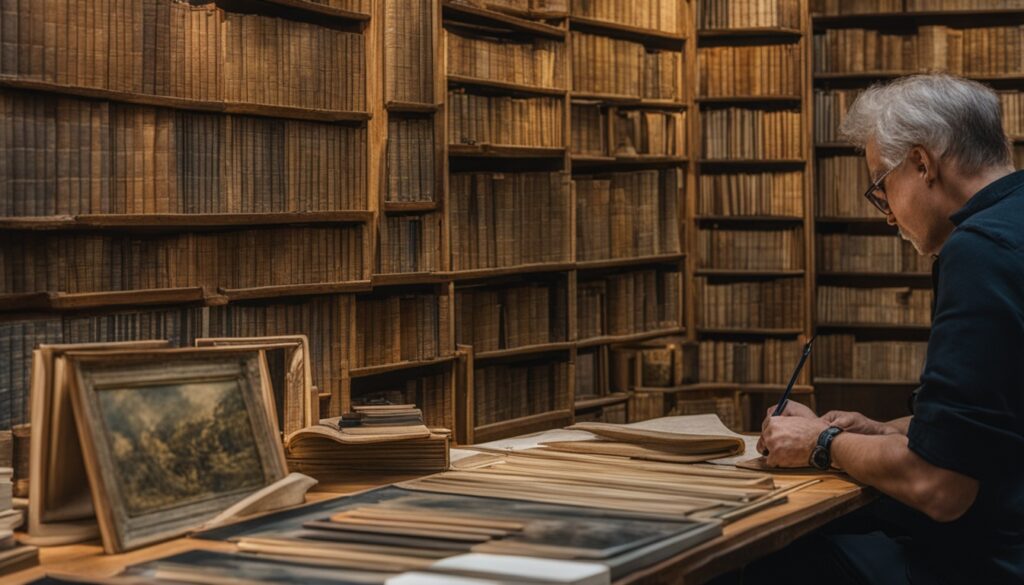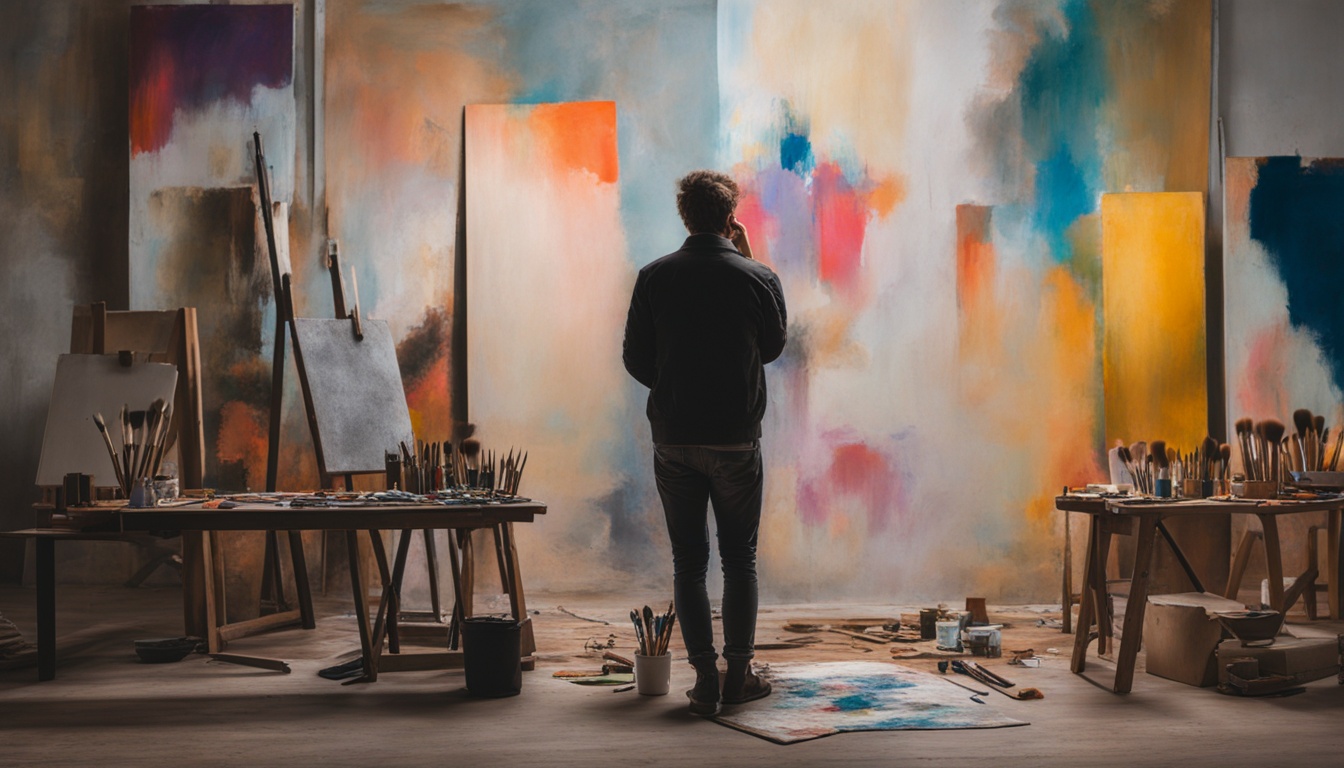Have you ever stood before a painting, feeling a rush of emotions, yet struggled to articulate what you saw? That moment of connection is where art appreciation for beginners truly begins. Art has an incredible power to evoke feelings, challenge our perceptions, and transport us to unfamiliar worlds. It’s not just about understanding what you see, but about immersing yourself in the deeper narratives that art conveys. As you embark on this journey of learning how to write art appreciation, remember that you can explore the multifaceted nature of art, bringing your voice and experience into the conversation.
By grasping the historical context, the significance of different styles, and the emotional resonance of artistic works, you can cultivate a deeper understanding of what you experience. As Edgar Degas wisely noted, “Art is not what you see, but what you make others see.” In this guide, you’ll uncover how to express your aesthetic perspectives and engage in the dialogue of art critique, ultimately enhancing your experience with both art and writing.
Key Takeaways
- Art appreciation is accessible to everyone, regardless of background.
- Engaging with art deepens your connection to diverse cultures.
- Understanding historical context enriches your perspective of art.
- Art reveals hidden meanings through symbols and emotional expressions.
- Visit galleries and utilize resources to expand your art knowledge.
- Your personal experience is vital in interpreting artistic works.
- Art movements provide a valuable framework for understanding styles and techniques.
Understanding Art Appreciation
Engaging with art enriches your life by deepening your understanding of the world around you. Defining art appreciation involves recognizing the value and significance of artworks, which are not limited to those with an art degree. Anyone willing to explore their relationships with visual elements can effectively engage in this journey.
Defining Art Appreciation
At its core, defining art appreciation means striving to comprehend and value art in various forms. This includes an exploration of visual elements such as line, shape, tone, color, pattern, texture, and form. These components allow you to break down artwork systematically, facilitating a deeper understanding of artistic intention and cultural context.
Art movements play a critical role in framing your appreciation. By classifying artists based on their periods or styles, you can recognize the evolution of artistic expression. An example is the Italian Renaissance, which spanned from the end of the 13th century to the beginning of the 16th century, highlighting a transformative era in art history.
Why Art Matters to Everyone
Art matters because it reflects cultural values and influences emotional intelligence. Engaging with artwork allows for empathetic connections and a broader understanding of diverse perspectives. The Rand Corporation report supports this idea, asserting that visual arts deepen connections with the world, inviting fresh interpretations.
Participation in art appreciation courses, such as those offered by StraighterLine, enlightens individuals on key themes, principles of design, and various art media. By completing these courses, you gain the ability to define important art vocabulary, classify mediums, and analyze artwork through cultural and historical lenses. Ultimately, embracing art transforms your viewpoint and enhances your life experience.

Emotional Engagement with Art
Art transcends mere visual stimuli. Emotional engagement with art plays a pivotal role in how you appreciate, interpret, and value creative works. This process involves your personal experience in art appreciation, where feelings and memories intertwine, shaping your understanding of various artistic expressions. Each piece of art invites you to connect not just with the visuals but with the emotions they evoke.
Connecting Emotionally with Artistic Works
Artworks possess the remarkable ability to stir emotions such as sadness, joy, and even fear. When you explore emotional engagement with artworks, you find layers of meaning that enhance your appreciation. Whether it’s a striking landscape painting or a poignant pop song, these pieces often resonate deeply within you, prompting reflections on your personal experiences and memories. This emotional response strengthens your connection to the artwork and heightens its significance in your life.
The Importance of Personal Experience
Your interpretations of art evolve through personal experience in art appreciation. Each encounter with a piece can elicit different reactions based on your history, cultural background, and emotional state. The simple act of viewing artwork can initiate a complex process where emotions surface, revealing insights into both the piece and your journey. This duality enriches the appreciation process, allowing art to function as a mirror that reflects societal norms and personal narratives.
Art appreciation is not static. As you grow and accumulate experiences, your understanding deepens, shaping your reactions and interpretations over time. Engaging with various forms of art, including crafts and cultural artifacts, fosters a more profound appreciation of their inherent emotional power. Ultimately, recognizing the interplay of emotions and personal narratives not only enhances your art experience but also invites a broader dialogue within the community about the significance of art in human expression.

How to Write Art Appreciation
Writing art appreciation essays provides an opportunity to explore and express your thoughts about various artistic creations. Understanding the key elements can enhance your ability to convey insights, making your writing more engaging for readers. Recognizing how to write art appreciation involves identifying important components such as subjects, techniques, and themes prevalent in the artwork.
Identifying Key Elements to Discuss
When engaging in structuring thoughts in art writing, focus on elements that resonate with your observations. This includes:
- Artist’s intent: Consider what the artist aimed to convey through their work.
- Historical context: Explore the period and situation in which the artwork was created.
- Emotional reaction: Reflect on how the artwork makes you feel and why.
Personal experience plays a vital role in your appreciation of art. Approaching pieces with an open mind allows for meaningful insights that deepen the reader’s understanding of your perspective.
Structuring Your Thoughts Clearly
To effectively convey your analysis, begin with an introduction that sets up the context for your insights. Organize your thoughts into paragraphs that discuss:
- The significance of the chosen artwork.
- The emotional and intellectual responses it evokes.
- A summary that synthesizes your observations, highlighting the different angles of appreciation.
Maintaining clarity throughout your writing fosters a richer experience for your audience, ensuring they connect with your exploration of how to write art appreciation.

Artistic Analysis Techniques
Understanding and employing effective artistic analysis techniques allows you to engage deeply with artwork. These methods involve breaking down compositional elements like balance, contrast, and focal points. Evaluating how various elements work together enhances your appreciation and critical insight into the piece.
Breaking Down Compositional Elements
When analyzing art, pay close attention to compositional elements. Here are a few key aspects to consider:
- Balance: Assess how visual weight is distributed within the artwork, creating stability or tension.
- Contrast: Examine differences in color, light, and texture that draw attention or highlight specific features.
- Focal Points: Identify where your eyes are directed and the significance of those areas.
Examining Symbolism and Allegories
Symbolism in art adds layers of meaning that invite deeper engagement. Artists often convey profound ideas through visual metaphors. For example, a lamb in Christian art conveys purity, whereas the lotus flower in Hindu art represents beauty. Understanding these symbols not only enriches your interpretation but also situates the artwork within a cultural context.

| Element | Definition | Example |
|---|---|---|
| Balance | The visual equilibrium in a composition. | Asymmetrical balance in “The Thames Below Westminster” by Claude Monet. |
| Contrast | The juxtaposition of differing elements. | Sharp color contrasts in “The Sea” by Childe Hassam. |
| Focal Point | The area where the viewer’s attention is drawn first. | The prominent figure in Edgar Payne’s coastal scenes. |
| Symbolism | Images that represent other meanings. | The lotus flower in various Eastern artworks. |
Evaluating Artistic Elements
Understanding how to evaluate artistic elements enriches your experience when engaging with artwork. This evaluation focuses not only on the visible traits but also on the emotional resonance that colors, shapes, and lines convey within a piece.
Color Usage and Its Impact
Color impact in art plays a pivotal role in shaping viewer perceptions. Artists often utilize color to evoke specific emotions or to create a defined atmosphere. For instance, a vibrant palette can communicate energy and joy, while darker shades might evoke a sense of melancholy. The contrast between colors can highlight significant areas of a painting, drawing attention to critical elements. By learning to recognize these color strategies, you gain insight into the artist’s intentions and the underlying narrative portrayed through their work.
Shapes and Lines: The Artist’s Guide
Shapes and lines in artwork are fundamental components that guide the viewer’s gaze and create movement within the composition. Each artist has their unique approach to using these elements; for example, smooth, flowing lines may suggest serenity, while sharp, jagged shapes can convey tension. These elements serve not just for aesthetic appeal but also communicate deeper meanings. Understanding how artists manipulate shapes and lines enriches your ability to appreciate their work on a more profound level.

Describing Artistic Styles
Understanding artistic styles enriches your appreciation of visual art. Each style offers distinct characteristics, helping you recognize and analyze various pieces effectively. Familiarity with major art movements enhances your ability to interpret artists’ intentions and connect with their work on a deeper level.
A Brief Overview of Major Art Movements
Notable art movements have significantly influenced the landscape of visual arts through distinct characteristics and ideas. Here are four prominent styles:
- Photorealism: This style focuses on creating paintings that resemble high-resolution photographs, emphasizing detail and clarity.
- Abstract: Artists eliminate recognizable forms, using shapes, colors, and textures to convey emotions or concepts, moving away from traditional representation.
- Whimsical: Characterized by playful and fanciful themes, this style often features exaggerated forms, bright colors, and imaginative subject matter.
- Composite: This approach blends elements from different styles or mediums, allowing for a unique creative expression that combines various techniques.
Identifying Styles through Visual Cues
Visual cues in art provide insight into the techniques and motivations of the artist. By observing elements like brushstroke styles, color palettes, and subject matter, you can gain a clearer understanding of how these factors define different artistic styles. For example, contemporary artists continue to embrace Impressionistic techniques, showcasing the lasting impact of this movement. Developing a personal art style often evolves throughout an artist’s lifetime, allowing for growth and exploration.
As you embark on your artistic journey, focus on cultivating your unique style. While artists today possess the freedom to explore various styles, concentrating on one or two can help you fully develop your artistic capabilities. This approach aligns with the objective of this guide, aiming to enable you to recognize and describe various artistic styles while engaging with the vibrancy of art.

| Art Movement | Key Characteristics | Notable Artists |
|---|---|---|
| Impressionism | Light brushwork, emphasis on capturing light | Claude Monet, Edgar Degas |
| Cubism | Fragmented objects, multiple perspectives | Pablo Picasso, Georges Braque |
| Expressionism | Intense emotion, vivid colors | Edvard Munch, Wassily Kandinsky |
| Pop Art | Mass media imagery, bold colors | Andy Warhol, Roy Lichtenstein |
Interpreting Visual Art
Art appreciation serves as a gateway to deeper engagement with visual pieces. Grasping the nuances of interpreting visual art requires a keen understanding of the art context in which the work was developed. Historical influences and the artist’s background play a critical role in shaping an artwork’s meaning and significance.
The Role of Context in Art Appreciation
To appreciate art fully, you must consider the environment surrounding its creation. The social, political, and cultural climate serves as a backdrop, illuminating the artist’s intent and message. By evaluating these factors, you gain insights into why particular themes or symbols are prevalent. Engaging actively with the art context can enhance your enjoyment and understanding of artistic works.
Understanding Cultural Significance
Recognizing the cultural significance of art enriches your viewing experience. Artistic expressions often address societal issues, prompting you to reflect on contemporary themes and your role within them. This reflection fosters a holistic understanding of the cultural narratives that artworks present. Such insights allow you to appreciate how art transcends its visual appeal, solidifying its relevance within society.

| Factor | Description | Importance |
|---|---|---|
| Historical Context | Events surrounding the creation of the artwork. | Enhances understanding of the artist’s intent. |
| Artist’s Background | Personal experiences influencing their work. | Provides insight into thematic choices. |
| Cultural Movements | Trends that impact artistic expression. | Contextualizes the significance of the piece. |
| Societal Issues | Examining how art reflects or addresses these challenges. | Creates a conversation around current events. |
Expressing Aesthetic Perspectives
Art appreciation thrives on the ability to communicate your unique viewpoints in art. This process involves more than just a mere observation; it requires a deep engagement with the emotions evoked by the artwork. By expressing aesthetic perspectives, you can share your personal reflections and insights, allowing others to see the artwork through your lens. Emphasizing individuality in your perspective fosters a rich dialogue about the piece, enriching the overall experience.
Sharing Your Unique Viewpoints
When sharing your unique viewpoints in art, focus on articulating what you see, feel, and think about the visual elements. Engaging with diverse art forms—ranging from classic paintings to contemporary sculptures—helps cultivate a deeper understanding. By exploring terminologies such as chiaroscuro or techniques like impressionism, you enhance your ability to communicate effectively. Artistic encounters can trigger various emotional responses, contributing to your emotional intelligence while nurturing compassion for different viewpoints.
Writing Engaging Art Critiques
Writing art critiques requires a balance of analytical thought and emotional reflection. Developing unique perspectives involves critical examination of artworks, encouraging you to question norms and seek alternative views. Successful critiques incorporate not just the analysis of techniques and styles, but also how these elements resonate with personal experiences. Creativity and imagination flourish when you immerse yourself in art, empowering you to express insights that resonate with others while fostering a collective appreciation.

Art Appreciation Essays
Writing art appreciation essays allows for an exploration of artistic expression while promoting analytical thought. Such essays should provide clear arguments supported by evidence from various artworks. The discussion of themes in art can be quite engaging when you integrate personal interpretations alongside informed views.
Crafting Thoughtful and Analytical Essays
To create compelling analytical essays in art, begin with a thesis statement that clarifies your main argument. A well-structured approach is essential. Consider the following elements when crafting your essay:
- Length: The established standard volume typically ranges from 2 to 3 pages.
- Originality: Maintaining an original voice is crucial; even minimal plagiarism is considered unacceptable.
- Art Elements: Discuss elements such as line, shape, color, texture, value, and space, as they form the backbone of your arguments.
Using Examples to Support Your Views
Incorporate supporting examples in art writing to bolster your views. Analyzing specific artworks can provide powerful insights into a broader cultural context. For instance:
| Artwork | Artist | Significance |
|---|---|---|
| The Broken Column | Frida Kahlo | Evokes pain and resilience, prompting emotional responses. |
| Detroit Industry Murals | Diego Rivera | Signifies human labor and progress amidst the Great Depression. |
| Sunflower Seeds | Ai Weiwei | Explores themes of consumption and cultural identity through 100 million hand-painted seeds. |
Understanding an artwork’s historical and cultural context is vital in interpreting its meaning. This approach not only enhances your discussion but also enriches the reader’s appreciation of the art. Utilize these insights to make your art appreciation essays both comprehensive and engaging.

Conclusion
Embarking on the journey of how to write art appreciation can transform the way you perceive and engage with art. Summarizing the art appreciation tips presented throughout this guide, it becomes evident that understanding art is deeply rooted in personal experiences and emotional connections. By harnessing the techniques discussed—such as exploring visual elements, examining context, and articulating your unique perspectives—you can enrich your artistic insight. Teaching art appreciation is not just about learning to interpret the work of others, but also about honing one’s own artistic abilities and developing a deeper appreciation for the creative process. By sharing your newfound knowledge and passion for art with others, you can inspire a collective understanding and appreciation for the diverse expressions of human creativity. Ultimately, embarking on the journey of how to write art appreciation is an ongoing process of personal growth and enlightenment.
As you delve into the world of art, remember that appreciation comprises a significant part of your artistic development. It is not just about creation but also about recognizing and valuing the works of others. By developing your skills in writing about art, you enable yourself and your readers to engage in a dynamic conversation that inspires exploration and self-reflection. This activity is not merely educational; it is a pathway to lifelong learning and personal growth.
Ultimately, art is a universal language that resonates with everyone. Whether you are a novice or an experienced art lover, you possess the capability to express your views and appreciation for creativity. Embrace the adventure of art appreciation, and let it guide you to newfound knowledge and inspiration.









